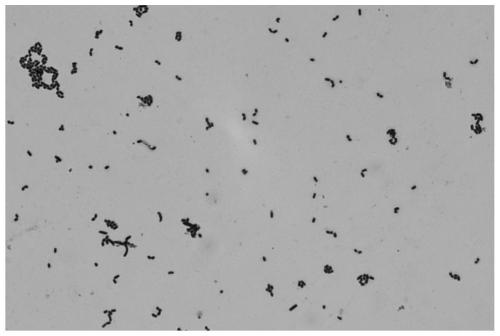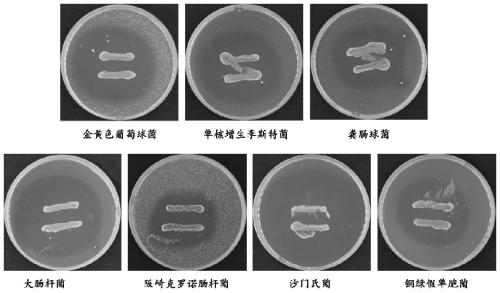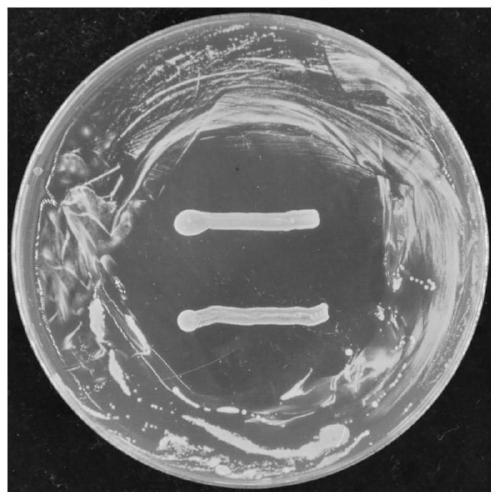Lactobacillus casei controlling bacterial soft rot of vegetables and its application
A technology of Lactobacillus casei and soft rot, which is applied in the field of microorganisms, can solve the problems of weak effect of streptomycin sulfate, etc., and achieve good application potential, high-efficiency growth inhibition, and high safety effects
- Summary
- Abstract
- Description
- Claims
- Application Information
AI Technical Summary
Problems solved by technology
Method used
Image
Examples
Embodiment 1
[0031] Embodiment 1: Screening and identification of antibacterial lactic acid bacteria
[0032] (1) Isolation of microbial strains
[0033] The pickle water samples were diluted with sterilized saline in a 10-fold dilution gradient. Take 100μL of 10 -2 、10 -3 、10 -4 、10 -5 The diluted kimchi water dilution was spread on the MRS solid medium, and incubated at a constant temperature of 37° C. for 48 hours. A single colony of lactic acid bacteria was picked, and the characteristic colony was further isolated and purified repeatedly by the streak separation method, and the morphological characteristics of each colony were recorded and observed by Gram staining microscope.
[0034] The MRS solid medium is composed of the following components in terms of mass percentage: 2% glucose, 1% peptone, 1% beef extract, 0.5% yeast extract, 0.5% sodium acetate, 0.1% Tween 80, dihydrogen citrate 0.1% of amine, 0.02% of magnesium sulfate, 0.005% of manganese sulfate, 1.5% of agar powder,...
Embodiment 2
[0043] Embodiment 2: the biological antagonistic activity of lactobacillus casei WX322 to carrot soft rot pectin bacillus
[0044] (1) In vitro activity
[0045] Lactobacillus casei WX322 was cultured in MRS liquid medium to OD 600nm = 0.8, use an inoculation loop to streak the bacterial suspension onto the MRS agar plate (2 parallel lines, about 2 cm in length), cultivate at a constant temperature of 37°C for 12h, pour 15mL of LB medium containing 2wt% agar onto the surface of the MRS plate to Cover Lactobacillus casei WX322. Inoculate the activated Pectin Bacillus of carrot soft rot in LB liquid medium, and cultivate it to OD at 37°C and 150rpm 600nm =1, use fresh LB medium to dilute 1000 times, draw 100 μL of bacterial suspension, use a sterile applicator to evenly disperse it on the surface of the aforementioned LB medium poured onto the surface of the MRS plate, and culture it statically at 37°C for 24 hours, Observe the size of the inhibition zone.
[0046] The resul...
Embodiment 3
[0050] Embodiment 3: the antibacterial activity of Lactobacillus casei WX322 metabolite
[0051] (1) Growth curve of Lactobacillus casei WX322
[0052] Pick a single colony of Lactobacillus casei WX322 and inoculate it in 10 mL of MRS liquid medium, culture it overnight at 37°C and 150 rpm, and use it as a seed fungus. The seed bacteria were inoculated into 3L MRS liquid medium with an inoculum amount of 0.1 wt%, and cultured statically at 30°C for 78h. During the culture period, sample 100mL every 6h, measure the pH value of the bacterial suspension, and use a spectrophotometer to measure the OD 600nm absorbance value.
[0053] The result is as Figure 5 As shown, Lactobacillus casei WX322 has a typical growth curve, which is in the lag phase in the first 12h, in the logarithmic growth phase in 18-54h, and enters the stable phase after 54h; in the whole fermentation process, the pH value of the fermented liquid gradually decreases, and finally Stable below pH 4.
[0054]...
PUM
 Login to View More
Login to View More Abstract
Description
Claims
Application Information
 Login to View More
Login to View More - R&D
- Intellectual Property
- Life Sciences
- Materials
- Tech Scout
- Unparalleled Data Quality
- Higher Quality Content
- 60% Fewer Hallucinations
Browse by: Latest US Patents, China's latest patents, Technical Efficacy Thesaurus, Application Domain, Technology Topic, Popular Technical Reports.
© 2025 PatSnap. All rights reserved.Legal|Privacy policy|Modern Slavery Act Transparency Statement|Sitemap|About US| Contact US: help@patsnap.com



